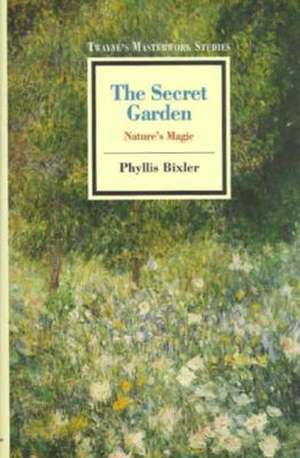Masterwork Studies Series: The Secret Garden (Cloth): Twayne's Masterworks Studies, cartea 161
Autor Phyllis Bixler, P. Bixleren Limba Engleză Hardback – 31 iul 1996
Each volume:
-- Illuminates themes and concepts of a classic text
-- Uses clear, conversational language
-- Is an accessible, manageable length from 140 to 170 pages
-- Includes a chronology of the author's life and era
-- Provides an overview of the historical context
-- Offers a summary of its critical reception
-- Lists primary and secondary sources and index
Din seria Twayne's Masterworks Studies
- 23%
 Preț: 449.34 lei
Preț: 449.34 lei -
 Preț: 377.65 lei
Preț: 377.65 lei -
 Preț: 344.04 lei
Preț: 344.04 lei -
 Preț: 454.10 lei
Preț: 454.10 lei -
 Preț: 432.73 lei
Preț: 432.73 lei -
 Preț: 452.73 lei
Preț: 452.73 lei -
 Preț: 522.80 lei
Preț: 522.80 lei -
 Preț: 207.23 lei
Preț: 207.23 lei -
 Preț: 321.90 lei
Preț: 321.90 lei -
 Preț: 434.85 lei
Preț: 434.85 lei -
 Preț: 274.30 lei
Preț: 274.30 lei -
 Preț: 434.64 lei
Preț: 434.64 lei -
 Preț: 432.88 lei
Preț: 432.88 lei -
 Preț: 359.34 lei
Preț: 359.34 lei -
 Preț: 209.56 lei
Preț: 209.56 lei -
 Preț: 497.93 lei
Preț: 497.93 lei -
 Preț: 475.05 lei
Preț: 475.05 lei -
 Preț: 349.31 lei
Preț: 349.31 lei -
 Preț: 348.89 lei
Preț: 348.89 lei -
 Preț: 349.31 lei
Preț: 349.31 lei -
 Preț: 499.29 lei
Preț: 499.29 lei -
 Preț: 455.79 lei
Preț: 455.79 lei -
 Preț: 456.98 lei
Preț: 456.98 lei -
 Preț: 350.47 lei
Preț: 350.47 lei -
 Preț: 288.91 lei
Preț: 288.91 lei -
 Preț: 432.35 lei
Preț: 432.35 lei -
 Preț: 347.75 lei
Preț: 347.75 lei -
 Preț: 288.69 lei
Preț: 288.69 lei -
 Preț: 347.75 lei
Preț: 347.75 lei -
 Preț: 272.55 lei
Preț: 272.55 lei -
 Preț: 347.36 lei
Preț: 347.36 lei -
 Preț: 321.68 lei
Preț: 321.68 lei -
 Preț: 349.86 lei
Preț: 349.86 lei -
 Preț: 350.47 lei
Preț: 350.47 lei -
 Preț: 455.03 lei
Preț: 455.03 lei -
 Preț: 455.79 lei
Preț: 455.79 lei -
 Preț: 453.12 lei
Preț: 453.12 lei -
 Preț: 455.03 lei
Preț: 455.03 lei -
 Preț: 456.39 lei
Preț: 456.39 lei -
 Preț: 453.50 lei
Preț: 453.50 lei -
 Preț: 454.86 lei
Preț: 454.86 lei -
 Preț: 453.30 lei
Preț: 453.30 lei -
 Preț: 351.00 lei
Preț: 351.00 lei -
 Preț: 349.09 lei
Preț: 349.09 lei
Preț: 349.48 lei
Nou
Puncte Express: 524
Preț estimativ în valută:
66.87€ • 69.83$ • 55.22£
66.87€ • 69.83$ • 55.22£
Carte indisponibilă temporar
Doresc să fiu notificat când acest titlu va fi disponibil:
Se trimite...
Preluare comenzi: 021 569.72.76
Specificații
ISBN-13: 9780805788143
ISBN-10: 080578814X
Pagini: 108
Dimensiuni: 145 x 220 x 17 mm
Greutate: 0.32 kg
Editura: Twayne Publishers
Seria Twayne's Masterworks Studies
ISBN-10: 080578814X
Pagini: 108
Dimensiuni: 145 x 220 x 17 mm
Greutate: 0.32 kg
Editura: Twayne Publishers
Seria Twayne's Masterworks Studies
Textul de pe ultima copertă
During the first part of this century, critics compiling lists of the best children's literature tended to ignore Frances Hodgson Burnett's The Secret Garden (1911). Instead, Burnett was remembered primarily for her earlier, phenomenally popular Little Lord Fauntleroy (1886), an Anglo-American Cinderella tale. After Little Lord Fauntleroy, Burnett had gone on to write romances for children and adults that brought her wealth and fame but were received by the critics with increasing disdain. By the 1950s, however, it was The Secret Garden that readers had obviously come to consider a "classic": it has continued to top polls of child readers, has continued to appeal to many adults as well as children, and has never gone out of print. During the last two decades, The Secret Garden has received much attention from literary critics and has been honored with three film adaptations (1975, 1987, and 1993), an opera and a children's opera (both in 1991), and two adaptations for the musical stage (1983 and 1991). Its rich characterization and mythic imagery and themes have allowed it to transcend its own era; it has been described as ahead of its time for the accuracy with which it reflects our contemporary understanding of child psychology. In this comprehensive study of Burnett's masterwork, its literary milieu, and its enthusiastic, if belated, critical treatment, Phyllis Bixler argues that Burnett adapted themes and forms from fairy tales and moral tales about exemplary children to create a compelling story. Bixler discusses Burnett's debt to the romantic movement and the long western tradition of literary pastoral, showing how its association of childhood and garden makes Burnett's children'sclassic a bridge between the romantic and such hallmarks of the moderns T. S. Eliot's Four Quartets and D. H. Lawrence's Lady Chatterley's Lover. Bixler addresses the mythic appeal of The Secret Garden, its description and encouragement of children's self-reliance, its treatment of the themes of loss and death, and its portrayal of the garden as a source of regeneration. Bixler suggests that bias against books perceived as having a primarily female readership may have contributed to the decline in Burnett's reputation during the first half of the twentieth century; she surveys the copious feminist, psychoanalytic, and ideological readings The Secret Garden has been given in recent years and devotes a chapter to the gender and class perceptions that permeate Burnett's narrative. Bixler concludes that the garden and the cooperation of various characters rather than the actions of its two protagonists - Mary Lennox and Colin Craven - lie at the center of Burnett's book, which provides a nearly utopian vision of nurturance, especially, though not exclusively, female nurturance.
